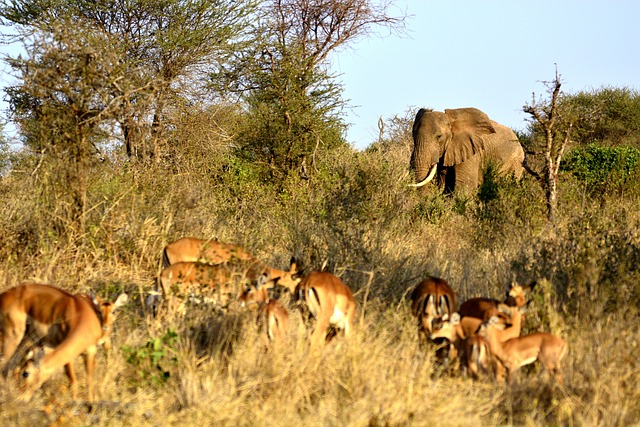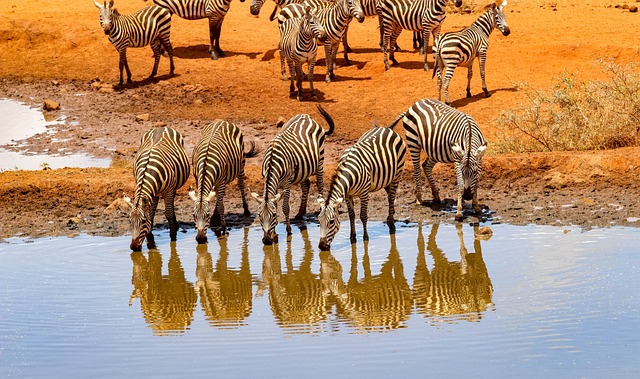Amboseli National Park is located in south Kajiado in Kenya and borders Tanzania. The park is 39206 ha (392.06 km sq.) in size. It has a rich history from 1906 when it was set aside as the southern reserve for the Maasai community and it was later returned to local authority as a game reserve in 1948. It was declared a UNESCO site in 1991. Currently Amboseli national park is operated fully by the national government under the Kenya Wildlife Services (K.W.S). The park boasts three of the big five wild animals which are elephants, lions and few leopards. Other wild animals in the park include wild beasts, hippos, ostrich, zebras etc. Amboseli National park receives a revenue of approximately $3.3 million dollars annually from the visitors who come to Amboseli. From this revenue, part goes to the national government and part of it is used for daily activities in the park but also the park uses part of this revenue for corporate social services or what is known as giving back to the society.

We set out and travelled to Amboseli to find out the millstones achieved by Amboseli national park regarding corporate social responsibility. We accessed the park at the Iremito gate. We were well received by the game ranger and after checking our Identification cards we started our game drive driving through the vast and beautiful Amboseli ecosystem. As we enjoyed the drive, we started our interview with the game ranger. He has a solid experience in Amboseli having worked there for more than five years. Before we started our interview we were amazed by the beautiful views of Mt Kilimanjaro and we were given an interesting fact that Mt Kilimanjaro was initially under the Kenyan territory but was given to Tanzania as a birthday gift by the colonial governor to Kenya that time. Amboseli national park gives back to the society in many different ways which we will analyze below.
Giving scholarships to students around the community. The Maasai community around the Amboseli national park is one of the communities that has maintained it’s African culture. This means that most of the community members do not believe in the modern system of education and most kids in the community do not attend schools despite the availability of schools around. The Amboseli national park has partnered with other organizations like UNICEF and Amboseli children’s Fund to sponsor students in the community to go to school and get quality education. This is done through giving scholarships to students who perform well in school who are given top priority when distributing the funds. The scholarships cater for the student’s tuition, uniform and also food in the school. The project has benefited many students around Kajiado and some have studied from primary to college level. The scholarships are grants and therefore the beneficiaries are not required to pay.
The national park has also created local employment to members of the community. Upon arriving at the Iremito gate, we were amazed to see Maasai women dressed in Maasai shakes selling cultural ornaments. I bought a Maasai necklace for ksh500 and the lady told me they earn about Kshs. 1000 per day and they are able to cater for their family’s needs. They are happy that the park attracts hundreds of visitors every month who buy their products. Inside the park as we were enjoying our game drive, we found youths who were plating trees inside the park. The place was well fenced for security purposes and there were armed game rangers guarding the youths. The youths were from the local community and were given the job to plant indigenous trees which were becoming extinct inside the park. This keeps the youths from around busy and earns them extra cash for their upkeep. The Amboseli national park is a major employer in Kajiado.
Another activity that Amboseli does to the surrounding community is supplying clean water to the community. Kajiado is a county that rarely receives adequate rainfall and therefore the area is very dry. The locals sometimes don’t get access to clean water for domestic use. Inside the park, climate change has increased water levels in the lakes inside the park. Water comes from Mt Kilimanjaro and the Kenya Wildlife Services through their machines they filter the water and supply it to the locals. The water is transported to the community and supplied in tanks available in institutions such as schools, hospitals etc. The locals get access to clean water during dry seasons courtesy of Amboseli National park. However, this activity is not carried out on a daily basis only when there is sufficient water from the park is when they can supply extra to the locals.

Compensating locals whose property has been destroyed by wild animals. The Amboseli National Park is not fully fenced and therefore wild animals sometimes cross to the villages around. Some animals destroy crops of farmers and kill domestic animals of the locals. We asked the ranger why they couldn’t fence the whole park to prevent such incidents and he said “If we fence the whole park the animals might die in large numbers. The vegetation inside is not plenty. They benefit from locals also” He said while smiling. However, the park’s management has partnered with a non-profit organization called Born Free and together they investigate and compensate locals whose property has been destroyed by wild animals. This has played a major role in maintaining a good relation between Kenya Wildlife service and the community members.
Participating in local development. The Kenya Wildlife services also participates in local developments such as funding building of classrooms in schools and partnering with local leaders to build dispensaries which in return, benefit the locals. The K.W.S in Amboseli has partnered with Land and life foundation and constructed four classrooms costing $60,000 and a fully equipped library for $75,000 both in Esiteti Primary school located in Tortilis camp in Amboseli. The facility has a population of 469 children,230 boys and 239 girls who benefit from the academic infrastructure courtesy of Amboseli National Park.
In conclusion, the Kenya Wildlife Services has done a great job to enhance a good community relation by giving social services like giving scholarships to students in form of grants, supplying clean water to the community during dry season, participating and funding local developments in the community etc. Amboseli National Park is great place to visit and we enjoyed our vacation enjoying the fresh air and beautiful scene. I recommend this park to all since the park takes care of the animals and the community as well.
Article by a group of 7 Members,
- Victor Oranja
- Pauline Maingi
- Brian Kiprop
- Mitchell Wainaina
- Jabir Mohamed
- Daniela Mutunga
